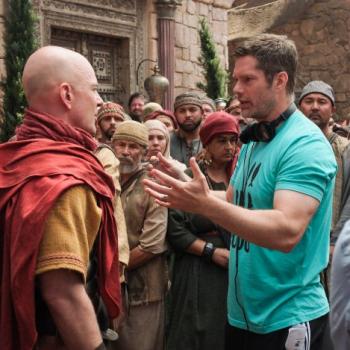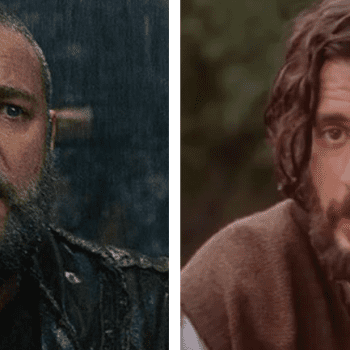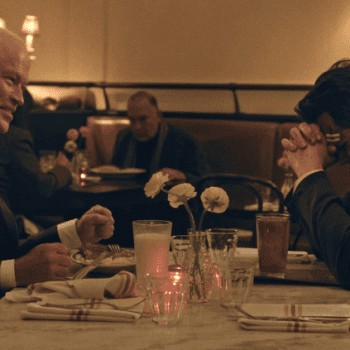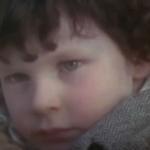Two years ago, I made a spreadsheet charting the similarities and differences between The Bible and its big-screen spin-off Son of God. Last year, I wrote detailed recaps for each episode of A.D. The Bible Continues, noting how the series made use of both the scriptures and secular history. Now it’s Risen’s turn to go under the microscope.
I have seen the film three times now, and on the third occasion I took detailed notes, including the approximate start and stop times of each scene. What follows is a list of those scenes, noting which details come straight from the New Testament and which details may be at odds with it to one degree or another. And since the studio has released several clips from the film on YouTube, I have added those to the list below, too. (More clips are available via WingClips but don’t seem to be embeddable here.)
Timecodes are approximate, based on an online screener that I streamed last week.
1:40 – 3:10 — Prologue
Clavius walks through a desert and stops at a tavern, where the owner recognizes the tribune’s ring on his finger. A subtitle sets this scene in “Judaean Desert, A.D. 33”.
No one knows exactly when the death and resurrection of Jesus happened, but Luke 3:1-2 says John the Baptist began his ministry “in the fifteenth year of the reign of Tiberius Caesar” — which, given that Tiberius began reigning in AD 14, would be circa AD 28 — and the ministry of Jesus began sometime after that. The ministry of Jesus itself is often thought to have lasted three years because John’s gospel says there were at least three Passover festivals during his ministry (John 2:13, 6:4, 13:1).
3:10 – 6:20 — The battle
Clavius begins his voice-over: “Thirty years, the Roman Empire of Tiberius…” Tiberius had actually been Emperor for 19 years by AD 33, and the Romans had held sway over the region for much longer — though Judea had been governed by a Roman prefect, rather than a Herodian king, since AD 6, i.e. 27 years before the movie begins.
Clavius executes a Zealot leader named Barabbas on the battlefield. Is this the same Barabbas who was set free by Pontius Pilate in Jesus’ place, a few hours before this scene takes place (Mark 15:6-15, Matthew 27:15-26, Luke 23:13-25, John 18:38-40)?
6:20 – 9:30 — Pilate gives Clavius his orders
Pilate alludes to the trial of Jesus (Mark 15:1-15, Matthew 27:11-26, Luke 23:1-25, John 18:28-19:16), but it is over before the scene begins.
Pilate washes his hands privately the way one of the gospels describes him washing them publicly before the crowd (Matthew 27:24).
9:30 – 16:05 — The Crucifixion
The sky goes dark (Mark 15:33, Matthew 27:45, Luke 23:44-45) and the earth shakes (Matthew 27:51-52) as Clavius and Lucius ride out of Jerusalem. The three gospels that mention the darkness all agree that it lasted three hours, and Matthew says the earthquake happened after that — but in the film, the darkness is fairly brief.
A centurion says Jesus died after six hours (Mark 15:25-37) and that his last words were “It is finished.” (John 19:30)
The legs of the thieves are broken, but Jesus, who is already dead, is pierced with a spear instead (John 19:31-37).
Mary Magdalene is there at the Crucifixion (Mark 15:40-41, Matthew 27:55-56, John 19:25; cf. Luke 23:49), as is the mother of Jesus (John 19:25-27). All four gospels say that other women were present at the Crucifixion, and John says a male disciple was there as well, but none of those other people are depicted here.
The centurion says, “Surely this man was innocent!” (Luke 23:47; cf. Mark 15:39, Matthew 27:54)
Joseph of Arimathea arrives with permission from Pilate to take the body of Jesus (Mark 15:42-26, Matthew 27:57-60, Luke 23:50-54, John 19:38). Nicodemus helps him (John 19:39).
16:05 – 19:00 — The bath
Clavius tells Pilate he helped to bury Jesus, and he says there were “many admirers” at the burial (Mark 15:47, Matthew 27:61, Luke 23:55).
19:00 – 20:10 — The cremation
Clavius oversees the funeral for his fellow Roman soldiers.
20:10 – 21:50 — The priests ask for a guard to be stationed at the tomb
The Jewish priests ask Pilate to put a guard outside the tomb, to make sure the disciples don’t steal Jesus’ body (Matthew 27:62-65). Caiaphas tells Pilate that he and his fellow priests “seek only what Caesar seeks: peace in Jerusalem” (cf. John 19:12).
21:50 – 24:30 — Securing the tomb
The tomb is sealed (Matthew 27:66).
24:30 – 25:15 — Night time at the tomb
One of the guards by the tomb shares his wine with the other.
25:15 – 29:50 — The body of Jesus is missing
Caiaphas tells Pilate the guards need to be kept alive so that they can spread the story that the body of Jesus was stolen (Matthew 28:11-15).
Clavius finds the burial shroud of Jesus in the tomb. Jesus had been wrapped “in a clean linen cloth” (Matthew 27:59) and/or “strips of linen” (John 19:40), and after the Resurrection, the disciples found “strips of linen” in the tomb (Luke 12:42, John 20:5-6), “as well as the cloth that had been wrapped around Jesus’ head. The cloth was still lying in its place, separate from the linen” (John 20:7).
Joseph of Arimathea says he and Nicodemus put only a few spices on Jesus’ body (John 19:40) because there wasn’t time to do more (Luke 23:54-56; cf. John 19:42).
Clavius tells Lucius to post a watch by the tomb, and to make sure that nothing there is touched. Presumably, then, this scene takes place after Peter, John, and various female disciples had made all of their visits to the empty tomb and spoken to Jesus and the angels there (Mark 16:1-8, Matthew 28:1-10, Luke 24:1-12, John 20:1-18).
29:50 – 32:35 — Clavius interrogates the first soldier
The soldier says the disciples stole the body (Matthew 28:12-15). Clavius pokes some holes in the story, and could have poked more (e.g. why did the disciples take time to remove the body of Jesus from its shroud while they were stealing it?).
32:35 – 33:45 — Lucius arrests a possible informer, digs up bodies
33:45 – 40:10 — A series of interrogations
Joseph of Arimathea says, “I believe Yeshua would have embraced you as a brother, even as you slew him.” This echoes Jesus’ call for forgiveness as he was being crucified (cf. Luke 23:33-34).
Joseph of Arimathea gives Clavius the crown of thorns (cf. Mark 15:17, Matthew 27:29, John 19:2).
Miriam, a blind woman, says she overheard the risen Jesus saying, “You are seeds already cast.” This echoes the Parable of the Sower (cf. Mark 4:1-20, Matthew 13:1-23, Luke 8:4-15). It is noteworthy, incidentally, that the film shows a number of people encountering the risen Jesus who do not seem to have been his followers beforehand; there are no accounts of anything like that in the New Testament.
Clavius prays to the Jewish God and tries to bargain with him.
The informer Lucius arrested says a friend of his heard about the Resurrection from two women — including Mary Magdalene — who went to the tomb and then met Jesus on the road (Matthew 28:1-10). Other gospels put a different number of women at the tomb: in John 20:1-18, Mary Magdalene seems to go by herself; in Mark 16:1-8, she is one of three women; and in Luke 24:1-11, she is one of at least five women. Mary Magdalene does not meet Jesus by the tomb in Mark or Luke, but she does meet Jesus by the tomb in John, and she and her companion meet him on the road in Matthew.
The informer states that Mary Magdalene is “a woman of the street”. There is no basis for this in the gospels, but western Christian tradition has often conflated Mary Magdalene with the “sinful woman” described in Luke 7:36-50. (Luke does not say what the sinful woman’s sin was, but it is typically assumed to have been sexual.)
40:10 – 41:55 — The search for Mary Magdalene
Clavius asks which of the Roman soldiers know Mary Magdalene. A rather high number of them raise their hands. This seems implausible, if Mary is — as her name suggests — from the town of Magdala in Galilee, rather than Jerusalem.
41:55 – 44:50 — The interrogation of Mary Magdalene
Clavius asks if the other woman at the tomb was Jesus’ mother, but Mary Magdalene does not answer. Matthew 28:1-10 — the only tradition that puts two women at the tomb — says the other woman was “the other Mary”, probably a reference to “Mary the mother of James and Joseph” who was at the Crucifixion in Matthew 27:56. (She might also be identical to “Mary the wife of Clopas” in John 19:25.)
None of the gospels put Jesus’ mother at the tomb. It’s possible that she was one of the “other women” mentioned in Luke 24:11, but — given her prominence in the Luke-Acts tradition — it’s worth noting that Luke doesn’t mention her by name here.
Lucius says Mary Magdalene may be bewitched, and asks if he should have her stoned. This may be a nod to the biblical story of Mary Magdalene’s exorcism (cf. Luke 8:2).
44:50 – 45:30 — Dream sequence
Clavius imagines Jesus hanging on the cross as it stands above the waves, out at sea.
45:30 – 46:20 — Clavius talks to Pilate
46:20 – 47:40 — The informer tells Clavius where to find Bartholomew
The informer mentions that there were twelve disciples in Jesus’ inner circle, but are now only eleven. This presumably reflects the fact that Judas Iscariot betrayed Jesus (cf. Mark 14:43-46, Matthew 26:47-50, Luke 22:47-48, John 18:2-3) and is no longer in the group; it may also be a nod to Judas’s suicide (cf. Matthew 27:3-5).
Bartholomew is listed among the disciples in three of the gospels (Mark 3:18, Matthew 10:3, Luke 6:14) and is still listed among them after the Resurrection (Acts 1:13), but the gospels do not attribute any particular words or actions to him — though some traditions do identify him with Nathanael, who has a brief conversation with Jesus in John’s gospel (John 1:43-51) and is later one of seven disciples present for the miraculous catch of fish after the Resurrection (John 21:1-14).
47:40 – 52:00 — The interrogation of Bartholomew
During his interrogation, Bartholomew mentions the teaching of Jesus that we should “render unto Caesar what is Caesar’s” (Mark 12:13-17, Matthew 22:15-22, Luke 20:20-26).
52:00 – 54:10 — Clavius shows Pilate the corpse he found
Pilate says he needs Clavius in Hebron. Hebron is mentioned numerous times in the Old Testament but not in the New Testament.
54:10 – 1:00:00 — Clavius interrogates the second soldier
Lucius tells Clavius the soldiers have fled the Temple and have come into some money (Matthew 28:12).
Clavius says the stone fell “ten paces from the tomb,” and the soldier says “the stone flew like a leaf.” Three of the gospels says the stone was rolled away from the tomb (cf. Mark 16:4, Matthew 28:2, Luke 24:2); the fourth simply says it was “removed” (cf. John 20:1).
The soldier says there was a “flash” before the stone flew away — possibly a reference to the angel that rolled it away, whose “appearance was like lightning” (Matthew 28:2-3). The two angels who appeared to the women at the tomb later on also wore “clothes that gleamed like lightning” (Luke 24:4).
The soldier describes a voice and a figure that came out of the tomb, though neither of these things are mentioned in the gospels. (Films like The King of Kings and The Passion of the Christ have shown Jesus walking out of the tomb, but this never happens in the gospels. In fact, given that Jesus appears and disappears at will in the Resurrection accounts, some theologians have argued that the stone was rolled away not to let Jesus out but to let other people in to see that Christ was already gone.)
1:00:00 – 1:00:50 — Clavius studies the tomb and the shroud
1:00:50 – 1:07:55 — Clavius finds the upper room
Clavius leads one last search for the apostles and spots Mary Magdalene outside the upper room.
Clavius gently pushes the door open, and once inside, he sees the risen Jesus — mere moments before Thomas runs through the open door and into the room to speak to the resurrected Jesus, who offers to let Thomas touch his wounds (John 20:26-29). This is a little different from the account in John’s gospel, where Thomas was already in the room when Jesus appeared (and the doors were locked).
After Jesus vanishes, the disciples debate what to do next. Peter says, “He said stay in Jerusalem until we receive some spirit” (which sounds like a mash-up of Luke 24:49 and John 20:22; cf. also Acts 1:4-5). Mary Magdalene replies, “Galilee. When he appeared on the road, this was said: ‘Tell my brothers to go to Galilee, and there they will see me.’” (Matthew 28:10) The disciples decide to go to Galilee, then.
1:07:55 – 1:09:30 — Lucius and Pilate come to the upper room
Lucius reads a note left behind by Clavius, and wonders if maybe it’s true that Jesus has come back from the dead. Pilate says he’ll kill Jesus again.
1:09:30 – 1:10:40 — Clavius follows the disciples
1:10:40 – 1:11:20 — Pilate tells Lucius to follow Clavius
Pilate tells Lucius he’ll be in Caesarea soon because the Emperor Tiberius is arriving in “ten days”. This scene seems to take place just a day or two after Jesus appeared to Thomas, and — based on the scenes that follow — it seems that the Emperor will arrive sometime after the Ascension takes place. This is problematic, as the appearance to Thomas happened on the eighth day of the Resurrection (John 20:26) and the Ascension happened on the fortieth day (Acts 1:3) — so the gap between these two things should be 32 days, or over a month, not a dozen days or less.
1:11:20 – 1:19:30 — The disciples (and Clavius) go to Galilee
The disciples say the Lord’s Prayer, but they begin it by addressing “Yahweh”, rather than “Father” (as per Luke 11:2-4) or “Our Father in heaven” (as per Matthew 6:9-13).
Clavius helps the disciples escape from Lucius and the other Romans.
1:19:30 – 1:29:55 — The disciples (and Clavius) at the Sea of Galilee
Peter says, “It was here that he called us to follow him” (Mark 1:16-20, Matthew 4:18-22, Luke 5:1-11).
Peter decides to go fishing, and the other disciples join him. They catch nothing at night, but then, the next day, Jesus appears to them on the shore and tells them to cast their nets on the right side of the boat, where indeed they catch a lot of fish. Peter immediately gets into the water and heads for shore on his own, leaving the other disciples to bring the catch of fish to shore, where they all eat with Jesus (John 21:1-14). Note: only seven disciples were involved in the gospel’s version of this story, but all eleven disciples — and Clavius! — are involved in the film.
Bartholomew tells Clavius that Jesus predicted his Resurrection, but the disciples doubted it (Mark 8:31, 9:9-10,31-32; Matthew 16:21, 17:9,22-23, 20:17-19; Luke 9:22).
Jesus heals a leper. There are no accounts in the gospels of Jesus healing anyone after his Resurrection, but he did heal lepers during his ministry (cf. Mark 1:40-45; Matthew 8:1-4, 11:5; Luke 7:22, 17:11-19). He also instructed his disciples to heal lepers and perform other miracles during his ministry (cf. Matthew 10:1-8).
Jesus takes Peter aside and asks him, three times, “Do you love me?” (John 21:15-19)
1:29:55 – 1:33:15 — Clavius speaks to Jesus on the rock
Jesus says to Clavius, “With your own eyes you’ve seen, yet still you doubt. Imagine the doubt of those who will never see — that’s what they [the disciples] face.” This is a slightly different version of Jesus’ words to Thomas (cf. John 20:29), and Clavius’s doubt is reminiscent of the doubt expressed by some of the disciples who saw Jesus in Galilee (cf. Matthew 28:17).
1:33:15 – 1:35:26 — The Ascension
Jesus walks towards the horizon, occasionally turning around to address the disciples: “I go to prepare a place for you (John 14:2-3). Go, into all the world, and preach the gospel (Mark 16:15) to all nations (Matthew 28:19). You will be my witnesses in Jerusalem, in all Judea and Samaria and to the ends of the earth (Acts 1:8). And know that I will be with you, always (Matthew 28:20).”
Jesus ascends into heaven (Luke 24:51, Acts 1:9). In the Bible, the Ascension takes place a short walk from Jerusalem, in the vicinity of Bethany, and not in Galilee as it does in the film. Also, in the film the Ascension is obscured by the rising sun, whereas in Acts, Jesus seems to be visible until he disappears behind a cloud.
1:35-26 – 1:37:55 — Farewells
John, addressing some people by the Sea of Galilee, pats his chest and says, “It’s not just about life eternal, it’s about how life is lived. It changes you, here.” He then says to one of his fellow disciples, “I may use that again.” At the moment I am not aware of any Johannine teaching that this might be based on.
Peter tells Clavius to “join” the disciples and says, “This Spirit he promised, we’re called to receive it there [in Jerusalem].” Jesus told his disciples to wait in Jerusalem (Luke 24:49, Acts 1:4-5), and the Spirit did in fact arrive ten days after the Ascension on the feast of Pentecost (Acts 2). However, the idea that Clavius could “join” the disciples at this point is somewhat implausible, as the early Christians were all Jewish at this point and didn’t even discuss whether to accept Gentile converts until the Roman centurion Cornelius was baptized several years later (Acts 10-11).
Clavius says Peter is called “to fish”, and Peter says, “Aye, for men.” This echoes how Jesus told Peter and some of the other early disciples that he would make them “fishers of men” (Mark 1:17, Matthew 4:19, Luke 5:10).
1:37:55 – 1:38:40 — Caesarea
Pilate stands near the dock, watching the Emperor’s ship approach, and he tells Lucius, “I doubt we’ll ever hear from them again.” Little does he know that Pentecost is about to happen, and the disciples are about to stir up a fuss by preaching boldly in the Temple — but that is another subject for another film.
1:38:40 – 1:40:15 — Epilogue
Clavius tells the tavern owner, “I believe I can never be the same.” He then wanders back into the Judean desert (did he walk all the way back south from Galilee?).
The end.
–
June 1 update: The Blu-Ray and iTunes editions of Risen have five deleted scenes, two of which depict or hark back to passages from the gospels.
‘This Was Revenge’
Clavius and Lucius find the body of Judas hanging from a tree, and they assume the disciples killed Judas as revenge for betraying Jesus; as they walk away, some children pick up some coins from the ground beneath Judas. Matthew 27:3-10 says Judas gave the money back to the priests and then hanged himself — but Acts 1:18-19 says Judas bought a field with the money and then fell to his death there. Either way, the biblical Judas did not have his thirty pieces of silver with him any more when he died.
‘I Want to Understand’
Peter tells Clavius that he and the other Christians try to turn the other cheek, as Jesus taught them to do (Matthew 5:39, Luke 6:29). But Peter admits that he did not do this in Gethsemane, and that he cut off a man’s ear (John 18:10-11; the incident is also mentioned in Mark 14:47, Matthew 26:51-54 and Luke 22:49-51, but those gospels do not identify Peter as the attacker). Peter also says he denied Jesus three times (Mark 14:66-72, Matthew 26:69-75, Luke 22:54-62, John 18:15-27).
Peter says he has questions even though he was at Jesus’ side for three years. The gospels do not say how long Jesus’ ministry lasted but, as noted above, it is often thought to have lasted three years because John’s gospel says there were at least three Passover festivals during the ministry of Jesus (John 2:13, 6:4, 13:1).













